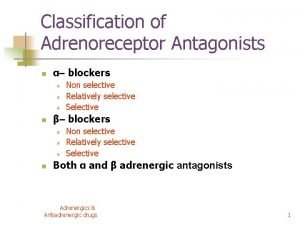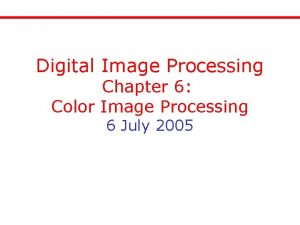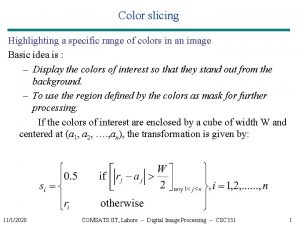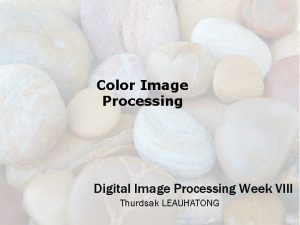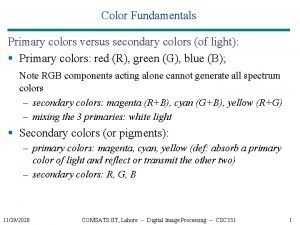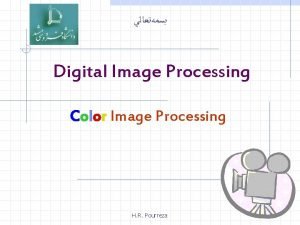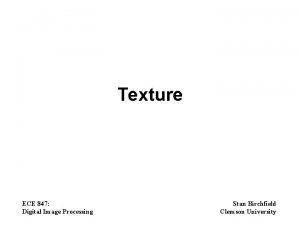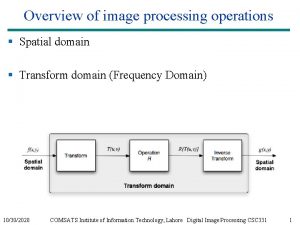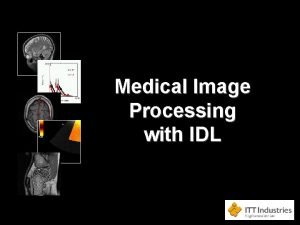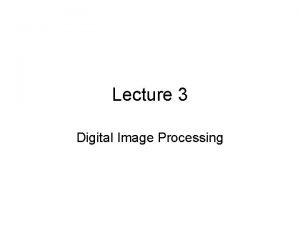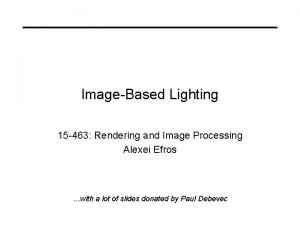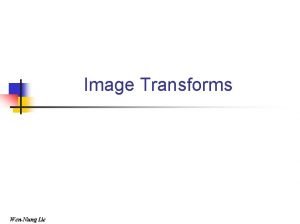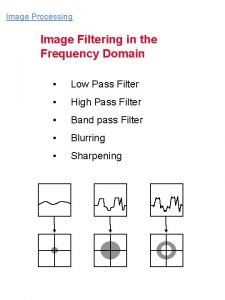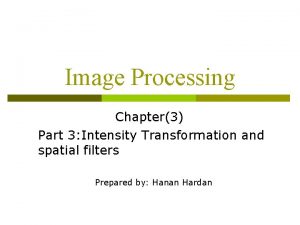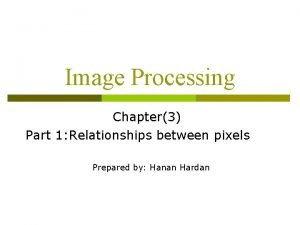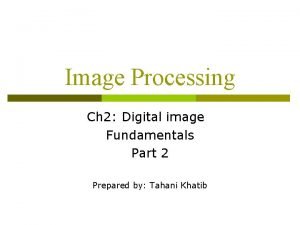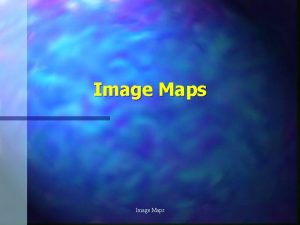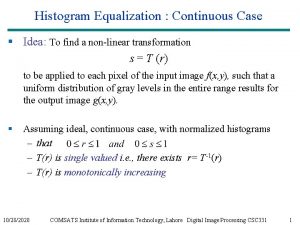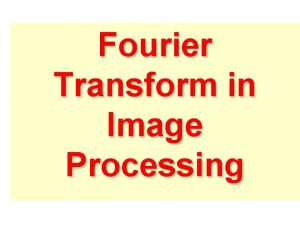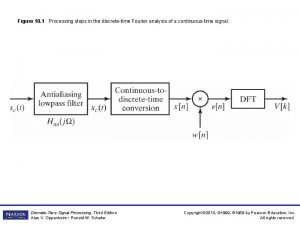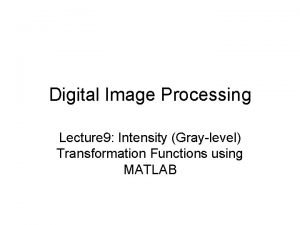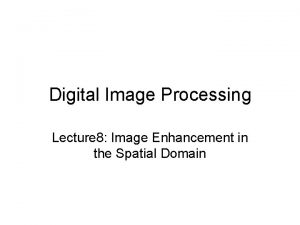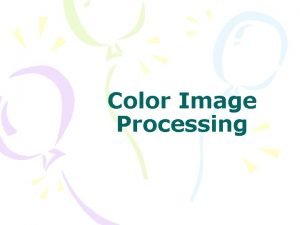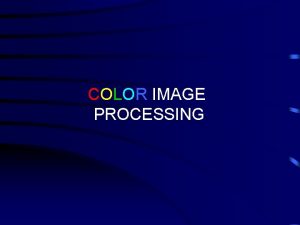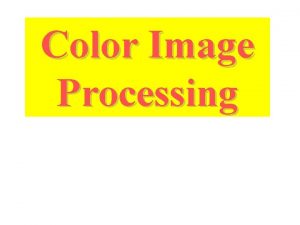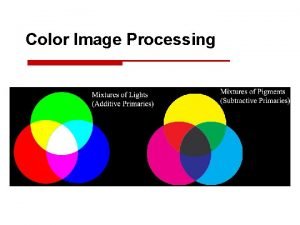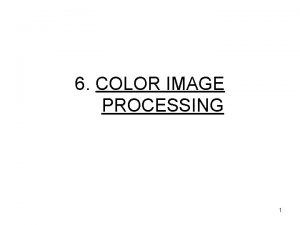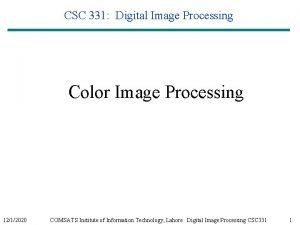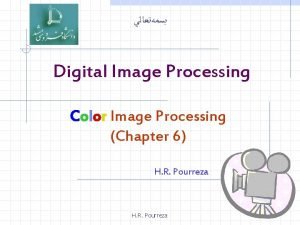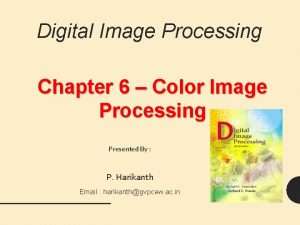Color Image Processing What is color Selective emissionreflectance



























![Gamut Transformation • Assume linear gamma • [X Y Z 1] T = M Gamut Transformation • Assume linear gamma • [X Y Z 1] T = M](https://slidetodoc.com/presentation_image_h2/7864c906285a9781ac8e0378ba43b4bf/image-28.jpg)
































- Slides: 60

Color Image Processing

What is color? • Selective emission/reflectance of different wavelengths

What is color? Illumination Reflectance

What is color stimuli? X Illumination Reflectance

Types of Color Stimuli 5

Perceived Color • The response generated by a stimulus in the cones gives the perceived color • Three responses 6

Computations on Color • Very difficult using spectrums • Can we have some sort of coordinate space to define color?

Tristimulus Values • Integration over wavelength λ=700 X = ∫C(λ)x(λ) = ∑ C(λ)x(λ) λ λ=400 λ=700 Y = ∫C(λ)y(λ) = ∑ C(λ)y(λ) λ λ=400 λ=700 Z = ∫C(λ)z(λ) = ∑ C(λ)z(λ) λ λ=400

CIE XYZ Space • Real colors span a sub-set of the XYZ space • Two different stimuli can have same XYZ values – Metamerism 9

Perceptual Organization of CIE XYZ Space • No physical feel as to how colors are arranged • How do brightness change? • How does hue change? 10

What are the perceived properties? • Intensity – Sum of the spectrum – Energy under the spectrum – I = X+Y+Z • Hue – Mean wavelength of the spectrum – What wavelength sensation is dominant? • Saturation – Standard deviation of the spectrum – How much achromatic/gray component? 11

perceived properties • Left: A and B have same intensity but different dominant wavelength and therefore different hues. • Middle: A and B have the same hue but different intensities. • Right: A and B have the same hue but different saturations. 12

Chrominance • Chrominance – Hue and saturation • Chrominance (x, y) = (X/I, Y/I) – Chromaticity chart – Projection on a plane with normal (1, 1, 1) – Reduction of dimension – Similar to 3 D to 2 D in geometry 13

What does this mean? • Scaling a vector (k. X, k. Y, k. Z) – (x, y) does not change – Each vector from (0, 0, 0) is an iso-chrominance line – Each vector map to a point in the chromaticity chart 14

Chromaticity Coordinates • Shows all the visible colors • Achromatic Colors are at (0. 33, 0. 33) – Why? – Called white point • The saturated colors at the boundary – Spectral Colors White Point 15

Chromaticity Chart • Exception is purples – Non-spectral region in the boundary • All colors on straight line from white point to a boundary has the same spectral hue – Dominant wavelength White Point 16

Chromaticity Chart • What happens here? – Complimentary wavelength – When mixed generate achromatic color • Purity (Saturation) – How far shifted towards the spectral color – Ratio of a/b – Purity =1 implies spectral color with maximum saturation B B’ b P a White Point (W) P 17

Luminance • Perceived brightness – Based on eye’s response • Same brightness green looks brighter than blue or red • This is proportional to Y 18

Perceptually Uniform Color Spaces 19

Color Mixing • Additive Color Mixtures • Subtractive Color Mixtures

Additive • Additive color mixtures modeled by addition in XYZ space • When spectrums get added – Displays Power C 1(λ) C 2(λ)

Subtractive • Subtractive like paint • Cannot be modeled by CIE XYZ space C 1(λ) Power C 2(λ) Wavelength

Additive Color Mixture • Add (X, Y, Z) coordinates • What does this mean in terms of brightness and chrominance? – Add brightness – Linear combination of chrominance in proportion of the brightness 23

What is the RGB color? Y ( Xg , Yg, Zg ) ( Xr , Yr , Zr ) X ( Xb , Yb , Zb ) Z X = i. Yr = i. Zg = ib X r Xg Xb Y r Yg Y b Z r Zg Zb

Color reproducibility • Only a subset of the 3 D CIE XYZ space called 3 D color gamut • Projection of the 3 D color gamut on the same plane with normal (1, 1, 1) – Triangle – 2 D color gamut • Cannot describe brightness range reproducibility

Specification Protocols • Brightness or Luminance • 2 D gamut – Large if using more saturated primaries

Current standards and devices
![Gamut Transformation Assume linear gamma X Y Z 1 T M Gamut Transformation • Assume linear gamma • [X Y Z 1] T = M](https://slidetodoc.com/presentation_image_h2/7864c906285a9781ac8e0378ba43b4bf/image-28.jpg)
Gamut Transformation • Assume linear gamma • [X Y Z 1] T = M [R G B 1] • Two devices T – [X Y Z 1] T = M 1 [R 1 G 1 B 1 1] – [X Y Z 1] T = M 2 [R 2 G 2 B 2 1] T T • [R 2 G 2 B 2 1]T = M 2 -1[X Y Z 1] = M 2 -1 M 1[R 1 G 1 B 1 1]T

Gamut Transformation • How to get the matrix from the standard spec? • Given (Y, x, y) or (I, x, y) for the three vectors, you can compute (X, Y, Z) – (x. Y/y, Y, (1 -x-y). Y/y) – (x. I, y. I, (1 -x-y). I) • Does not change the color, finds the new coordinates when using the new basis

Problem

Problem: Out of Gamut colors

Gamut Matching • Find a common color gamut defined by Rc, Gc, Bc • Find the common function Mc – [X Y Z 1]T = Mc [Rc Gc Bc 1]T • For any device i – [Ri Gi Bi 1]T = Mi-1 Mc [Rc Gc Bc 1]T

Two gamut

Find their intersection Need not be a parallelopipped

Find the common gamut

Find the mapping function

Gamut Mapping • Changing the actual colors – Mapping color in one gamut to another in the new gamut • If just dealing with two devices, may choose to move colors from one gamut to another

What is gamma function? ( Xg , Yg, Zg ) ( Xr , Yr , Zr ) ( Xb , Yb , Zb ) X = X r Xg Xb h ) Y r Yg Y b h r. Y( i r = Z hb g ( i= g ) Z r Zg Zb ( i b)

Tone Mapping Operator • How the input value maps to output intensity • Affects brightness, contrast and saturation

Tone Mapping Operator • How the input value maps to output intensity • Affects brightness, contrast and saturation

Transfer Function • Monotonic, smooth with no flat regions • Brightness and contrast controls

Image Correction

Color Balance • Relative proportions of primaries while forming a color • Affects hue, saturation and brightness • Can be changed by changing the transfer function

Color Balancing

Quantization • Digitization of color • Gray scale – infinite grays between 0 and 1 – 8 bit representation – 256 levels – A range of grays represented by a single value • Any value is assigned to one of k values • Choose number of levels and range of each level

Quantization Error Uniform Quantization Maximum Error = ½ Step Size Q(g) Quantization Error Step Size g

Is it constant across all levels? • Only when linear transfer function • Usually non-linear transfer function • Quantization error changes with input

Gamma Function – O = Iγ Output Intensity • Usually a gamma transfer function Display Gamma Input Intensity

• Note how quantization changes • Non-uniform step size • Maximum Error – ½ of maximum step size • # of levels is the color resolution – # of bits Output Intensity Non-Uniform Quantization Display Gamma Input Intensity

Color Resolution Analog Image 4 Steps 8 Steps 16 Steps Quantization Artifacts 64 Steps 32 Steps

Dithering • What if the color resolution is low? – Newsprint – Bi-level, only black and white • Can we expand the # of colors? – Spatial integration of eye • Trading off spatial resolution for intensity resolution

Dithering 0 2 1 3 • Represented by a dither matrix • nxn pixels, bi-level intensity, can produce n 2+1 intensities • If more than two levels – k levels – n 2. (k-1) +1 – Used for increasing the color resolution

Dithering • If more than two levels – k levels – n 2. (k-1) +1 – For k = 4 (0, 1, 2, 3) and n=2

Examples Loss of tone and details (Intensity and Spatial Resolution)

Subtractive Color System • Layers of cyan, yellow and magenta dyes – Absorb red, blue and green light • Depends on the illuminant • Act as absorption filter – Ideally block filters • Overlaying all the three dyes absorbs all wavelengths creating black

Creation of a color • CMY = (1, 1, 1) – RGB • (0. 25, 0. 75) = (1, 1, 1) – (0. 75, 0. 25) • This works only for block filters

Real Fiilters • Are not block filters • Cross talk across different filters • Due to ink impurities • Grays should be formed by equal amount of three primaries – Seldom happens

Why use black? • Better contrast • Use of inexpensive black in place of expensive colored dyes • Superimposing multiple dyes cause tearing of wet paper • K for key • Not an independent primary – Hence makes dark colors darker

Gray Balancing • The first step in printing is to decide how much of GCR to be used for the neutral grays • However, every gray needs to be decided separately • Called gray balancing • Usually done by iteration • No simple tristimulus model to decide components

Dependency on Content • Discussed content independent • Can also be done by understanding the color distribution of the particular content • Usually non-linear
 Adrenoreceptor
Adrenoreceptor Neighborhood processing in image processing
Neighborhood processing in image processing Point processing operations in image processing
Point processing operations in image processing Histogram processing in digital image processing
Histogram processing in digital image processing Nonlinear image processing
Nonlinear image processing پردازش تصویر
پردازش تصویر Morphological dilation
Morphological dilation Translate
Translate Optimum notch filter in digital image processing
Optimum notch filter in digital image processing Compression models in digital image processing
Compression models in digital image processing Key stage in digital image processing
Key stage in digital image processing Error free compression in digital image processing
Error free compression in digital image processing Image sharpening and restoration
Image sharpening and restoration Geometric transformation in digital image processing
Geometric transformation in digital image processing Steps in digital image processing
Steps in digital image processing Walsh transform in digital image processing
Walsh transform in digital image processing Maketform matlab
Maketform matlab Image restoration in digital image processing
Image restoration in digital image processing Hsi color wheel
Hsi color wheel Colour slicing
Colour slicing Rgb
Rgb ( 299 587 114 0 0 ) | ( 299 587 114 0 )
( 299 587 114 0 0 ) | ( 299 587 114 0 ) Color fundamentals in digital image processing
Color fundamentals in digital image processing Image processing
Image processing Bottom-up processing example
Bottom-up processing example Bottom up processing vs top down processing
Bottom up processing vs top down processing Bottom up and top down processing
Bottom up and top down processing Example of primary processing
Example of primary processing Parallel processing vs concurrent processing
Parallel processing vs concurrent processing Bottom down processing
Bottom down processing Batch processing vs interactive processing
Batch processing vs interactive processing Wwwimage
Wwwimage Image processing and analysis stan birchfield pdf
Image processing and analysis stan birchfield pdf Minimum perimeter polygon in digital image processing
Minimum perimeter polygon in digital image processing Flood fill algorithm are used to fill the
Flood fill algorithm are used to fill the Spatial operations in image processing
Spatial operations in image processing Opening image processing
Opening image processing Idl medical
Idl medical Aliasing in image processing
Aliasing in image processing Representation and description in digital image processing
Representation and description in digital image processing Font detector
Font detector Double thresholding matlab
Double thresholding matlab Nvidia npp
Nvidia npp Renender
Renender Orthogonal transformation in image processing
Orthogonal transformation in image processing Oerdigital
Oerdigital Band pass filter in image processing
Band pass filter in image processing Intensity slicing in digital image processing
Intensity slicing in digital image processing Relation between pixels in digital image processing
Relation between pixels in digital image processing Intensity transformation functions in image processing
Intensity transformation functions in image processing Zooming and shrinking in digital image processing
Zooming and shrinking in digital image processing Image maps are of two types
Image maps are of two types Hit or miss matlab
Hit or miss matlab Matlab histeq
Matlab histeq Fourier transform in image processing
Fourier transform in image processing Fourier image processing
Fourier image processing Bf image processing
Bf image processing Image processing lecture notes
Image processing lecture notes Ee583
Ee583 Imadjust
Imadjust Power law transformation in image processing example
Power law transformation in image processing example
